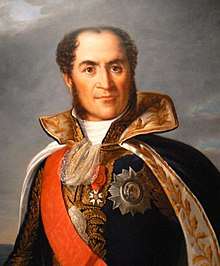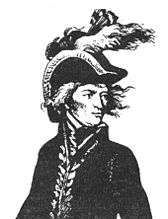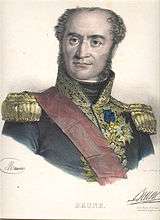Guillaume Brune
Guillaume Marie-Anne Brune, 1st Count Brune (13 March 1764 – 2 August 1816) was a French military commander, Marshal of the Empire, and political figure who served during the French Revolutionary Wars and the Napoleonic Wars.
Guillaume Brune Count of the Empire | |
|---|---|
 Portrait by Rose Jeanne Fajon | |
| Born | 13 March 1764 Brive-la-Gaillarde, France |
| Died | 2 August 1816 (aged 53) Avignon, France |
| Allegiance | |
| Service/ | Army |
| Rank | Marshal of the Empire |
| Awards | Grand Cross of the Legion of Honour |
Biography
Early life
The son of a lawyer, Brune was born at Brive-la-Gaillarde, Corrèze. He settled in Paris before the French Revolution, studied law, and became a political journalist. Following the outbreak of the Revolution, Brune joined the Cordeliers and was a friend of Georges Danton.
Revolutionary period
In 1793, Brune was appointed brigadier general and took part in the fighting of the 13 Vendémiaire (5 October 1795) against royalist insurgents in Paris. [1] In 1796, he served under Napoleon Bonaparte in the Italian campaign, and was promoted général de division for good service in the field. Brune commanded the French army that occupied Switzerland in 1798 and established the Helvetic Republic, and in the following year he was in command of the French troops in defence of Amsterdam against the Anglo-Russian invasion of Holland under the Duke of York, in which he was completely successful – the Anglo-Russian forces were defeated in the Battle of Castricum, and compelled, after a harsh retreat, to re-embark.[1] He rendered further good service in Vendée[1] and in the Italian Peninsula[1] from 1799–1801 (winning the Battle of Pozzolo).
In 1802, Napoleon dispatched Brune to Constantinople as ambassador to the Ottoman Empire. During his two-year diplomatic service, he initiated relations between France and Persia.
Napoleonic era
Following his coronation as Emperor of the French in 1804, Napoleon made Brune a Marshal of the Empire (Maréchal d'Empire). In 1808, Brune held a command of troops fighting in the North German campaign and occupied Swedish Pomerania, but his staunch republicanism and a meeting with Gustav IV Adolf of Sweden raised Napoleon's suspicions, and afterwards, he was not employed during the remaining years of the empire. [1]
Brune was recalled to active service in 1815 during the Hundred Days, and as commander of the Army of the Var, he defended Southern France against the forces of the Austrian Empire. He was murdered by mob of royalists during the Second White Terror in Avignon.[1] His body was thrown in the Rhône River, but was later recovered and buried in a pyramid-shaped tomb in the cemetery of Saint-Just-Sauvage.
Personal life
In 1793, Brune married Angélique Pierre. They had no issue but adopted two daughters.[2]
Gallery
 Brune as a young man
Brune as a young man Portrait by Auguste Vinchon
Portrait by Auguste Vinchon Brune as a Marshal of the Empire
Brune as a Marshal of the Empire
Sources
| Wikimedia Commons has media related to Guillaume Marie-Anne Brune. |

- Notice historique sur la vie politique et militaire du marechal Brune (Paris, 1821).
- Paul-Prosper Vermeil de Conchard, L'Assassinat du marechal Brune (Paris, 1888).
References
- Chisholm 1911.
- "Wives and Children of the Marshals". www.napoleon-series.org. Retrieved 31 May 2019.
.svg.png)